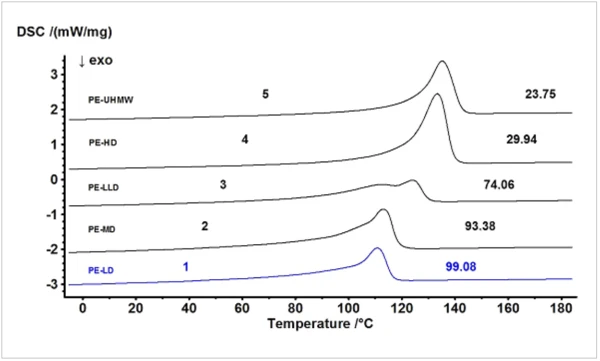Introduction
Differential Scanning Calorimetry (DSC) is a widely used method for determining the thermal behavior of polymers. By means of the Melting Temperatures and EnthalpiesThe enthalpy of fusion of a substance, also known as latent heat, is a measure of the energy input, typically heat, which is necessary to convert a substance from solid to liquid state. The melting point of a substance is the temperature at which it changes state from solid (crystalline) to liquid (isotropic melt).melting temperature characteristic for each polymer, information on the composition of unknown samples can also be gathered. Along with reference books, a software-based database is now also available for thermal analysis which compare measurement results with library data and allow for classification of the results based on similarities [1]. One can thus obtain valuable suggestions for identifying unknown samples even with little experience of one’s own [2].
In this work, the Identify database is employed to recognize different types of polyethylene and to rule out other substances based on a comparison of similarities.
Materials and Methods
Five types of polyethylene — PE-LD (low DensityThe mass density is defined as the ratio between mass and volume. density), PE-LLD (linear low DensityThe mass density is defined as the ratio between mass and volume. density), PE-MD (medium DensityThe mass density is defined as the ratio between mass and volume. density), PE-HD (high DensityThe mass density is defined as the ratio between mass and volume. density) and PE-UHMW (ultra-high molecular weight) — were available for characterization. Investigation of the melting behavior was carried out with the DSC 214 Polyma. The sample masses were between 10.0 mg and 15.0. The Concavus® aluminum crucibles were pressed with pierced lids and heated two times to 200°C in a nitrogen atmosphere at heating and cooling rates of 10 K/min.
Results and Discussion
A typically employed approach in instrumental analysis is to compare one’s own measurement results with comparative data stored in a database. For spectroscopic methods such as Fourier Transform Infrared Spectroscopy (FT-IR) or mass spectrometry (MS), databases are available which allow for such comparison. Until recently, this possibility was not available in thermal analysis. Only through the introduction of the software-based Identify database has this approach also found its way into thermal analysis [1]. For material identification, usually the second heating in DSC investigations is used, since the first heating is generally overlapped by process parameters, storage conditions or the thermal history of the sample. On the other hand, the second heating — after a controlled, linear cooling — shows the actual material behavior and therefore more readily allows for conclusions to the drawn about the material composition.
A comparison of the second heating runs for each of the different “PE” types is shown in figure 1. Additionally illustrated is the grading of the suggested PE types yielded by Identify. If, for example, PE-LD is measured (blue) and contrasted with the comparative values found by Identfiy, the sample can be recognized as PE-LD with similarity values of 99.08%. The other PE types, however, are classified as significantly lower similarity values.
The similarity values shown in figure 1 correspond to the first line in table 1. All results of the database comparison are summarized here. The first column shows the measured substance and the respective line for the similarity values found by Identify with the corresponding grading. The bisecting line thereby shows that the corresponding polyethylene type, with a similarity value of more than 98%, is assigned correctly. Similarity values of exactly 100% are never found since the measurements to be analyzed were performend on the same samples as those stored in the Identify database, but the identical measurement data are never compared. The values from table 1 are graphically illustrated in figure 2.

Table 1: Summary of the similarity values of all polyethylene types; the first column shows the measured samples, and in the other columns, the similarity values determined for each are shown.
| PE-LD | PE-MD | PE-LLD | PE-HD | PE-UHMW |
|---|---|---|---|---|---|
| PE-LD | 99.08 | 93.38 | 74.06 | 29.94 | 23.75 |
| PE-MD | 95.31 | 98.06 | 74.80 | 36.23 | 31.44 |
| PE-LLD | 70.50 | 72.52 | 98.29 | 80.47 | 73.96 |
| PE-HD | 31.14 | 37.57 | 76.77 | 99.90 | 95.64 |
| ÜE-UHMW | 23.99 | 28.32 | 69.69 | 94.41 | 99.74 |

Summary
The method of Differential Scanning Calorimetry (DSC) is suited for detecting the melting behavior of polymer samples. With the help of the Identify database, the determined measurement results can be compared with library data both visually and based on evaluated values. This also allows for reliable identification of the different polyethylene types. As already shown elsewhere, it is also possible to recognize the mixutre ratio [2 (a)]. Furthermore, the Identify database can be expanded by one’s own data and therefore be adjusted to individual needs.